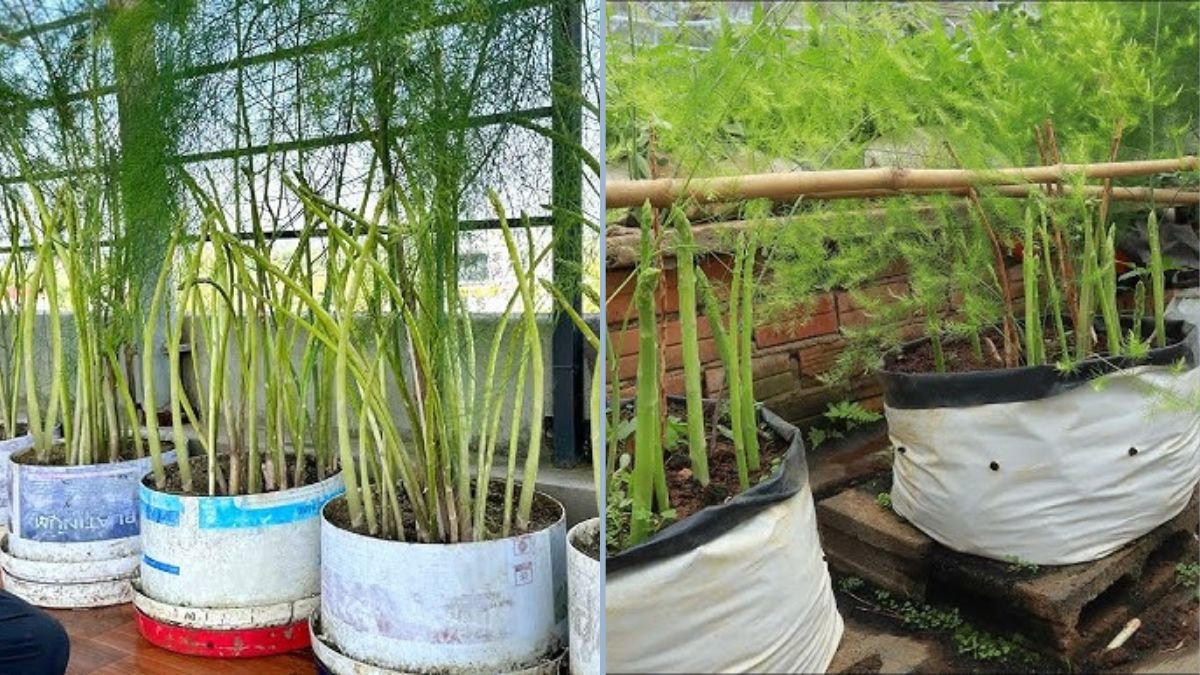Asparagus is a nutritious and delicious vegetable, celebrated for its tender stalks and distinctive flavor. Traditionally grown in garden beds, asparagus requires patience and care—but what if you don’t have a garden? With a little creativity, you can grow asparagus in plastic bottles, turning everyday waste into a productive gardening tool.
This method is not only space-saving and eco-friendly, but it also allows you to enjoy fresh asparagus all year round. In this comprehensive guide, we’ll take you through the process of growing asparagus in plastic bottles, from preparing the bottles to planting, caring, and harvesting.
Why Grow Asparagus in Plastic Bottles?
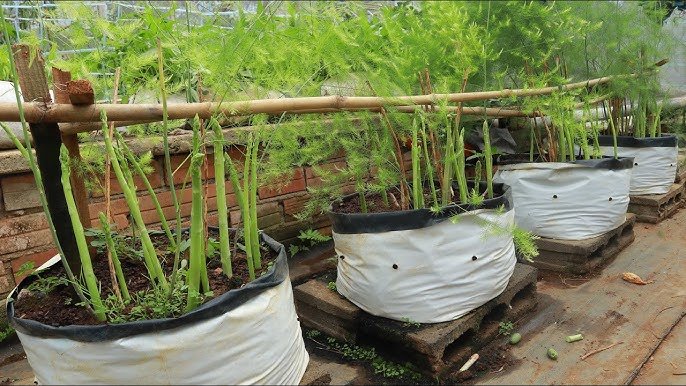
Plastic bottles are an inexpensive, recyclable option for growing vegetables, and they are perfect for small spaces. Here’s why plastic bottle gardening works for asparagus:
- Eco-Friendly: Reusing bottles reduces plastic waste while promoting sustainable gardening practices.
- Space-Saving: Ideal for rooftops, balconies, and indoor spaces.
- Cost-Effective: No need to buy expensive pots or planters.
- Portable: Bottles can be moved easily to adjust sunlight exposure or protect plants from harsh weather.
- Year-Round Growth: With careful management, you can maintain asparagus plants and harvest stalks throughout the year.
Materials You’ll Need
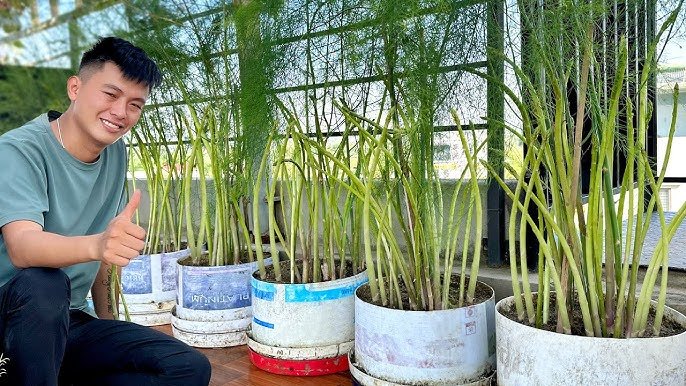
Before starting, gather the following materials:
- Large plastic bottles (2–3 liters work best)
- Utility knife or scissors
- Asparagus crowns or seedlings
- Nutrient-rich soil (mix of compost and garden soil)
- Small pebbles or gravel for drainage
- Water
- Cotton string or cloth (optional for self-watering system)
Step-by-Step Guide to Growing Asparagus in Plastic Bottles
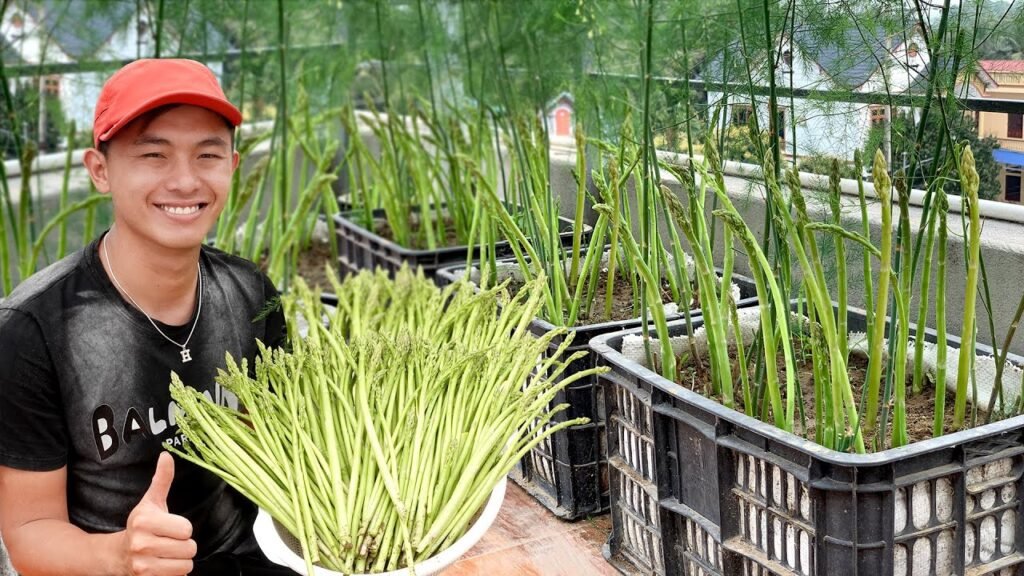
Step 1: Preparing the Plastic Bottles
- Wash the bottles thoroughly to remove any residue.
- Cut the bottle horizontally to create a planting container. The top half can be inverted into the bottom half to serve as a self-watering system.
- Make drainage holes at the bottom to prevent waterlogging.
Step 2: Adding Drainage Layer
- Place a layer of small pebbles or gravel at the bottom of the bottle.
- Drainage is essential to prevent root rot and support healthy asparagus growth.
Step 3: Filling with Soil
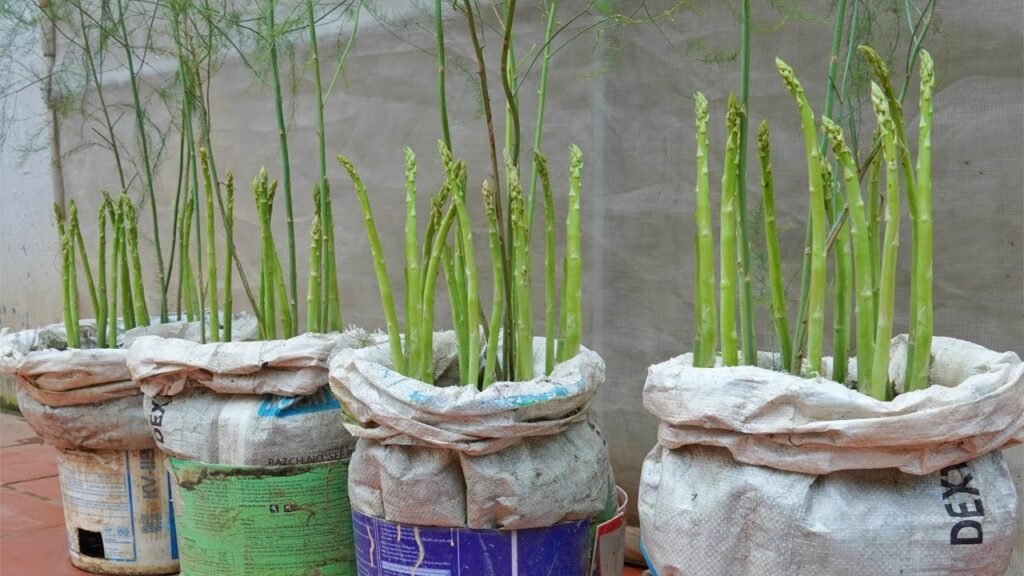
- Fill the bottle with nutrient-rich soil, leaving a couple of inches at the top for watering.
- A mix of compost and garden soil works best, providing nutrients and proper aeration for the roots.
Step 4: Planting Asparagus Crowns or Seedlings
- Use healthy asparagus crowns or seedlings for best results.
- Make a small hole in the soil and place the crown with roots facing downward.
- Cover lightly with soil and press gently to secure the plant.
- Space one crown per bottle to allow sufficient room for root growth.
Step 5: Watering and Care
- Water the soil gently to ensure consistent moisture.
- If using a self-watering system, fill the bottom reservoir and let the wick supply water gradually.
- Place the bottles in a sunny location receiving at least 4–6 hours of sunlight daily.
Caring for Asparagus Plants
- Watering: Keep the soil consistently moist, especially during the growing season. Avoid waterlogging, which can cause root rot.
- Fertilizing: Feed asparagus plants with a balanced fertilizer every 3–4 weeks. Nitrogen-rich fertilizers promote strong shoots.
- Mulching: Apply mulch around the base to retain moisture and reduce weed growth.
- Pruning: Remove dead or yellowing foliage to improve airflow and plant health.
Supporting Asparagus Growth
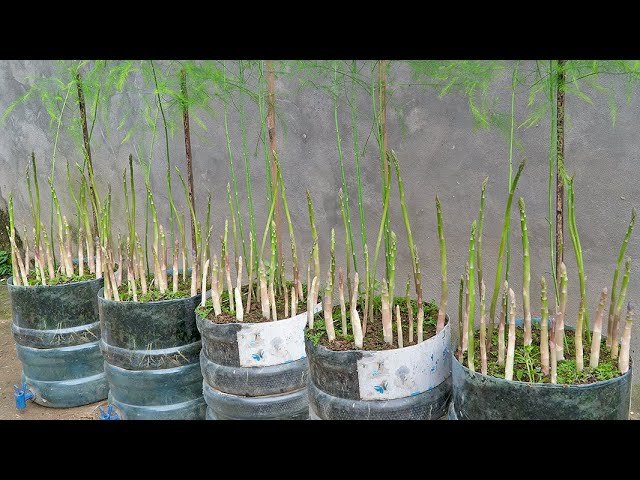
Asparagus grows tall and produces feathery foliage. Supporting your plants ensures healthy growth:
- Stakes or small trellises: Use supports to prevent bending or breaking, especially in windy areas.
- Wind protection: Place bottles in a sheltered location if needed to protect delicate shoots.
Pest and Disease Management
While asparagus is relatively hardy, it can be affected by pests and diseases:
- Aphids: Spray affected areas with mild soap or neem oil.
- Asparagus Beetles: Handpick beetles or use organic insecticidal solutions.
- Fungal Diseases: Powdery mildew or rust can occur. Ensure proper spacing, good airflow, and avoid overhead watering.
- Root Rot: Caused by waterlogging; proper drainage prevents this issue.
Harvesting Asparagus
- Asparagus plants usually take 1–2 years to establish before you can harvest significant yields.
- When shoots reach 6–8 inches tall, cut them at the base with a sharp knife.
- Harvest only a few shoots per plant at a time during the first year to allow the plant to establish strong roots.
- In subsequent years, you can harvest more frequently while maintaining plant health.
Benefits of Growing Asparagus in Plastic Bottles
- Year-Round Freshness: With proper care, you can enjoy asparagus throughout the year.
- Space-Efficient Gardening: Perfect for apartments, balconies, and urban spaces.
- Sustainable Practice: Recycling bottles reduces plastic waste while growing nutritious vegetables.
- Portable and Flexible: Bottles can be moved to adjust sunlight or protect plants during extreme weather.
- Educational and Rewarding: Growing asparagus teaches patience and offers the satisfaction of harvesting homegrown vegetables.
Common Mistakes to Avoid
- Overcrowding Plants: Only plant one crown per bottle for optimal growth.
- Neglecting Drainage: Poor drainage can lead to root rot. Always include pebbles and holes at the base.
- Overwatering: Too much water damages roots. Check soil moisture regularly.
- Insufficient Sunlight: Asparagus needs plenty of light for healthy growth.
- Harvesting Too Early: Avoid cutting too many shoots in the first year. Allow plants to establish strong roots.
Tips for Year-Round Growth
- Indoor Gardening: During cold seasons, move bottles indoors near a sunny window.
- Supplemental Lighting: Use grow lights if natural sunlight is limited.
- Regular Feeding: Fertilize periodically to maintain nutrient-rich soil.
- Continuous Planting: Plant new crowns every few months to maintain a steady supply of shoots.
Conclusion
Growing asparagus in plastic bottles is an innovative, space-saving, and sustainable way to enjoy fresh vegetables year-round. This method allows gardeners to make use of limited space while recycling plastic waste and cultivating a nutritious, high-value crop.
By following these simple steps—from preparing bottles and planting crowns to caring for your plants and harvesting—you can enjoy tender, flavorful asparagus in the comfort of your home. With patience and consistent care, your plastic bottle asparagus garden can provide fresh shoots all year, making it a rewarding and eco-friendly gardening project.
Whether you are an urban gardener, beginner, or eco-conscious enthusiast, this method demonstrates how creativity and resourcefulness can transform ordinary bottles into thriving asparagus gardens. Start small, care diligently, and watch your asparagus thrive from bottle to plate.
